
Plotly
August 19, 2025
What Vibe Coding Gets Wrong (and Why Vibe Analytics is Better)
Everyone keeps talking about vibe coding. It started as a joke, but the joke somehow stuck. Now it’s showing up in real workflows, shipped products, and production pipelines. Maybe it’s semantics, but there’s a difference between using AI to do your job better and offloading your brain to it and hoping something sticks.
If you've dabbled in vibe coding, it’s fun, it’s fast. But several people keep running into the same problems: things breaking for no reason, outputs you can’t recreate, apps that feel fragile no matter how much you tweak them. So we built Plotly Studio to handle what vibe coding doesn’t.
Plotly Studio is closer to what some are calling "vibe analytics" in that we’re helping the approximately one billion knowledge workers out there discover insights from their data faster and more reliably. Studio is spec-driven, opinionated about app structure, and built for analytics-specific workflows, not general-purpose coding. Analysts get a tailored interface with plain English in markdown, and skip the vibe coding debugging doom-loop for defaults designed to produce clean, functional results.
What is vibe analytics? How is it different from vibe coding?
Vibe analytics gives data analysts and domain experts working with data a way to build interactive data applications and business intelligence dashboards without full-stack development skills or the limitations of rigid BI software.
On the other hand, vibe coding is open-ended by nature. It is a methodology best suited for developers who already know what they want to make and want to move faster. That freedom appeals to some, but it comes with tradeoffs. These tools assume you understand the structure, the logic, and what the end result should be.
Plotly Studio avoids that use case entirely. It focuses on automatically generated apps based on a dataset, followed by totally optional prompting in plain English or even editing code. You are not learning a new DSL or wrangling YAML. Your prompt generates a structured spec, and that spec governs the code. You can inspect it, edit it, and reuse it. Everything stays visible and editable, whether you're working in text, spec, or Python. The results are professional, production-grade, and impressive:
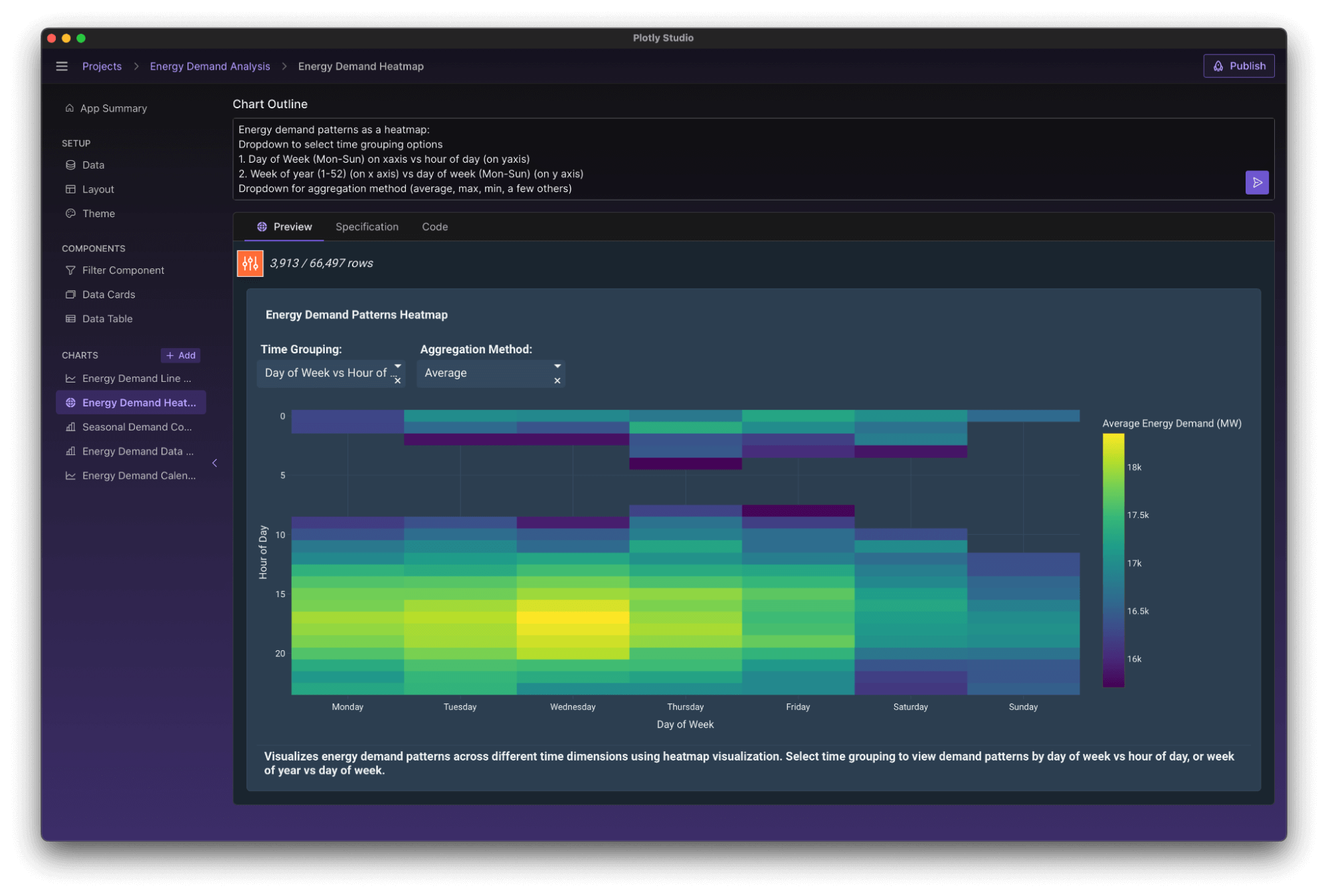
That structure sets Studio apart from legacy BI platforms. Those tools advertise natural language support, but layer prompts onto outdated architectures. You still end up boxed into static dashboards or slow semantic layers. Studio replaces the old model instead of layering prompts onto it.
The concept of vibe analytics leads to faster iteration and deeper control. It removes friction between question and answer, between dataset and app.
What vibe coding gets wrong
Here are the biggest flaws with vibe coding and how we’ve designed Plotly Studio to navigate these obstacles.
Hidden rewrites and surprise changes
A classic vibe coding failure: you ask for a small change in a prompt, and the model updates something totally unrelated. You just wanted to tweak a label, and now the app layout is broken. You change one chart, and a dropdown vanishes.
We address this by grounding every edit in the current state of the code. When you ask Plotly Studio for a change, the full context is provided. It knows exactly what it's changing. We tried requesting diffs from the model instead of full rewrites, but those weren’t reliable. So we do full rewrites, but with scoped templates and files. You’re editing a specific component, not the entire app.
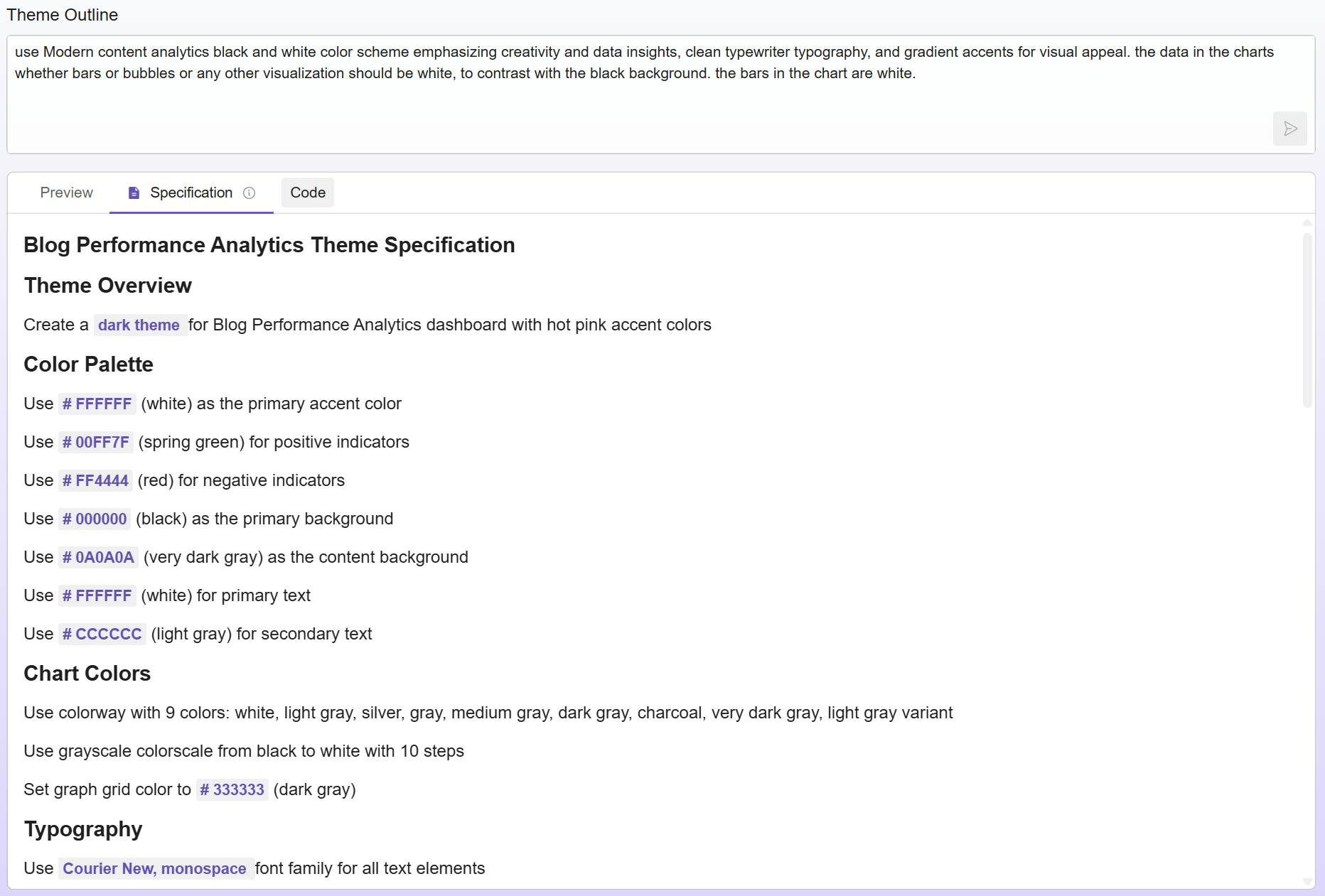
Specifications within Plotly Studio
We break apart apps into separate files by default. So you might be editing a chart or a control card. That change has no way of affecting unrelated parts of the app. That’s built into the structure.
Getting stuck in local minima
Another real problem: the model gets too cautious. You ask it to update a layout or rework a visualization, and it responds with something incremental or cosmetic, maybe a small label tweak, a minor color change, but nothing close to the broader update you asked for.
This pattern is known as getting stuck in local minima. In optimization problems, a local minimum is a solution that seems optimal in its immediate neighborhood, but isn’t the best possible solution overall. LLMs fall into the same trap when they focus too narrowly on prior context. They get anchored to what the code already looks like and become hesitant to make bold changes.
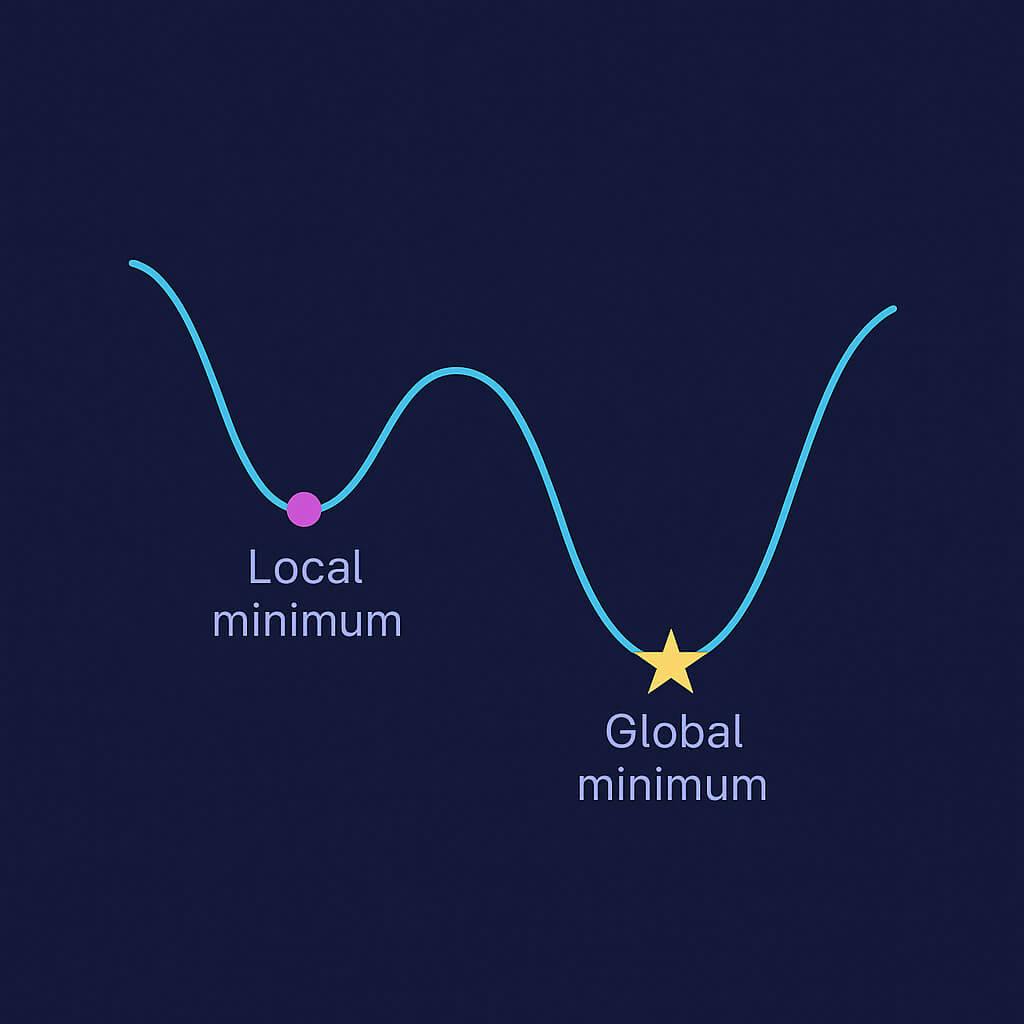
It’s the same idea as an optimization model getting stuck in a shallow valley where it thinks it’s found the best answer, but it’s too anchored to previous steps to explore better ones.
To solve this in Studio, we introduced "Remix" mode. Instead of giving the model the previous version of the code, Remix mode starts fresh. It regenerates the component from scratch with no memory of past implementations. We also increase the temperature setting—a parameter that controls how exploratory or creative the model can be. Higher temperature means the model is more likely to propose alternate structures, not just minor tweaks.
The intent within your prompt still drives the output, but it resets the context enough to break out of unhelpful loops and discover better directions.
You can’t recreate what worked
One of the most frustrating parts of vibe coding is inconsistency. You use the same prompt and get different results.
Studio is spec-driven. The spec describes exactly what the app should do. That becomes the stable source of truth. You can revise it (through prompts), copy parts into prompts, or use it to recreate the same app somewhere else.
Let’s say you prompt: “Make a bar chart showing sales over time.” Studio might decide that “over time” means “per day”. You read the spec, see the choice, and lock it in by updating your prompt to say: “Aggregate by day.” Or make it a dropdown.
Specs document what you said and then reveal what the model assumed. That visibility makes it easy to take control.
You can’t share it
Sharing chat transcripts is not collaboration. You can’t rerun them. You can’t remix them. With Studio, the spec is the unit of work. You can send it to a teammate, and they can generate the same app. They can also update the spec or build off of it.
Specs are portable. They’re remixable, and they scale.
No clear starting point
Most vibe coding interfaces greet you with a blank screen and a prompt box. That can be empowering if you know exactly what you want to build. But many people don’t know where to start. Open-endedness is a double-edged sword: you get flexibility, but you lose consistency.
Plotly Studio flips this: you start with a dataset. We generate a working app by default, with charts, filters, and interactivity already in place. You don’t need to know what’s possible. The output is self-explanatory. Then you prompt to improve it. We’ve found in practice that our data visualization and analytics AI agent actually helps discover insights and visualizations you would never have thought of or prompted for.
Studio is also intentionally opinionated. It has a house style. Apps have structure, layouts are coherent; in summary, the defaults are strong. You can still customize everything, but we give you something that follows best practices out of the box.
Core features missing
We’ve seen users rolling their own login systems in other vibe tools. Writing full auth flows from scratch. That’s wild. That’s how you get security issues.
Studio ships with built-in auth. We’re adding native data connectors. You shouldn’t have to rebuild foundations every time.
Code doesn’t matter (until it does)
There’s a common line in vibe coding circles: the code doesn’t matter. We disagree. The code matters. It contains the assumptions that define your app.
Plotly Studio doesn’t ask you to write code, but it makes it easy to interpret. We expose those assumptions. For example, when you ask for a dropdown by time of day, the model might define options like Morning (6AM–12PM) and Evening (6PM–12AM). That definition lives in the code. You might want to revise it. You might want to know exactly how "night" was defined. You should be able to see that.
Same goes for technical parameters. In a simulation, there might be something like epsilon = 0.02. That detail matters, and we surface it.
You can’t debug it
When something doesn’t work in a chat interface, you can often ask the AI follow-up questions like "Why didn’t this work?" or "What would you change?" That conversational loop can help clarify intent or debug simple issues. But in prompt-based workflows like Studio, that back-and-forth isn’t built into the interface yet. There’s no live chat thread to consult.
Instead, Studio is building a logging system to bring that level of insight into the core workflow. The goal is to let you trace how the app changed, what spec was used, what the model generated, and what assumptions were made along the way. We think this is better than back-and-forth prompting because the scope of debugging becomes smaller and easier to manage.
The prompt is compressed intent
We think about intent and output as a spectrum of compression.
In this model, natural language prompts are the most compressed form of input. They’re quick to write and easy to reason about, but they’re also lossy (meaning they don’t carry every detail you might expect in the output).
When you prompt something like “Add a dropdown for time of day,” the model fills in the blanks: it decides what counts as “time of day,” what the options should be, and how to group the data. That vagueness is the cost of working fast.
The next layer is the auto-generated spec. It unpacks those assumptions. You’ll see that “time of day” turned into options like Morning (6AM–12PM) and Evening (6PM–12AM). The spec makes implicit choices explicit. It’s less compressed, more verbose, more detailed, but still easy to read and edit.
The final layer is the code. This is the full fidelity output: every filter, every transformation, every conditional is spelled out. It's the least compressed and most precise expression of what the app does.
Studio gives you access to all three layers. You can write in compressed prompts, inspect and edit the semi-structured spec, or dive into the code when you need full control. This makes the workflow fast without being opaque, and flexible without being chaotic.
- The prompt is the most compressed form of intent. It’s vague and lossy.
- The spec is a structured intermediate.
- The code is the fully expanded version.
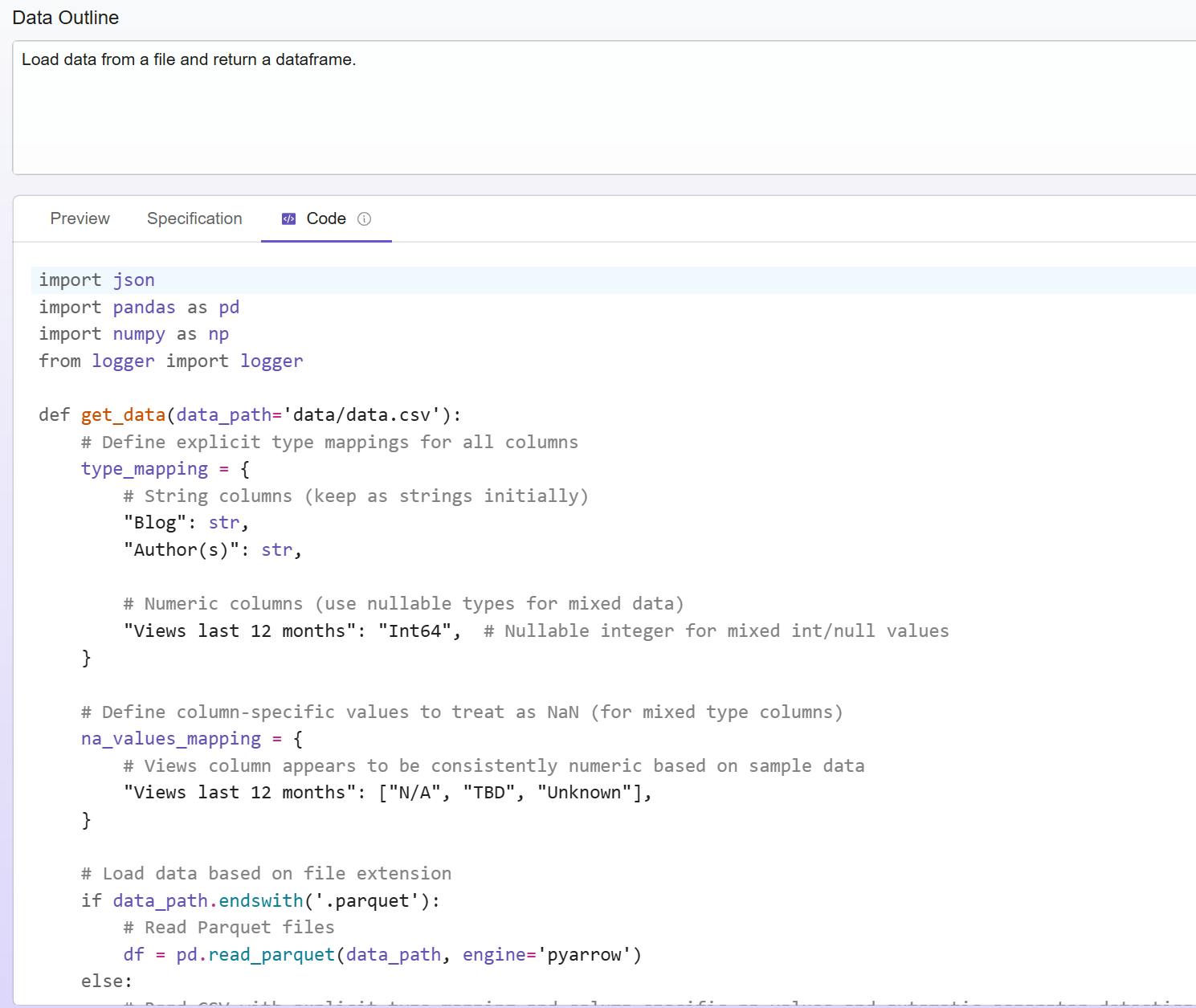
You can operate at any level. Start vague, then inspect and revise. We make all three layers visible. That’s how you keep the workflow fast and understandable.
Where we land
We’re not really trying to help developers vibe their way through anything. We’re not building a general-purpose LLM wrapper.
We’re building a structured, spec-driven environment where analysts and domain experts can do real work with data. It starts with a dataset and ends with a beautiful, interactive app that’s easy to share, hard to break, and safe to trust.
You can still vibe. We just give your vibes somewhere solid to land.
Why Plotly Studio is a better alternative for vibe analytics
Jokes part, vibe coding makes sense in theory. It’s fast, flexible, and gets you somewhere quickly. But that speed comes at a cost: inconsistent results, missing structure, poor defaults, and a lack of traceability. That’s fine if you’re prototyping in isolation, but hurts your cause if you're trying to deliver real, shareable work.
Plotly Studio is built for vibe analytics.
It gives you a direct path from dataset to data app. You can start with a spreadsheet and a plain-English prompt like "Bar chart of support tickets by time of day." Studio generates a working app immediately. But it doesn’t stop at vibes, it shows you exactly how it interpreted your request: which time segments it used, how it grouped the data, and what assumptions it filled in. If something’s off, you just copy that part of the spec, edit it in place, and regenerate. And the results are fantastic.
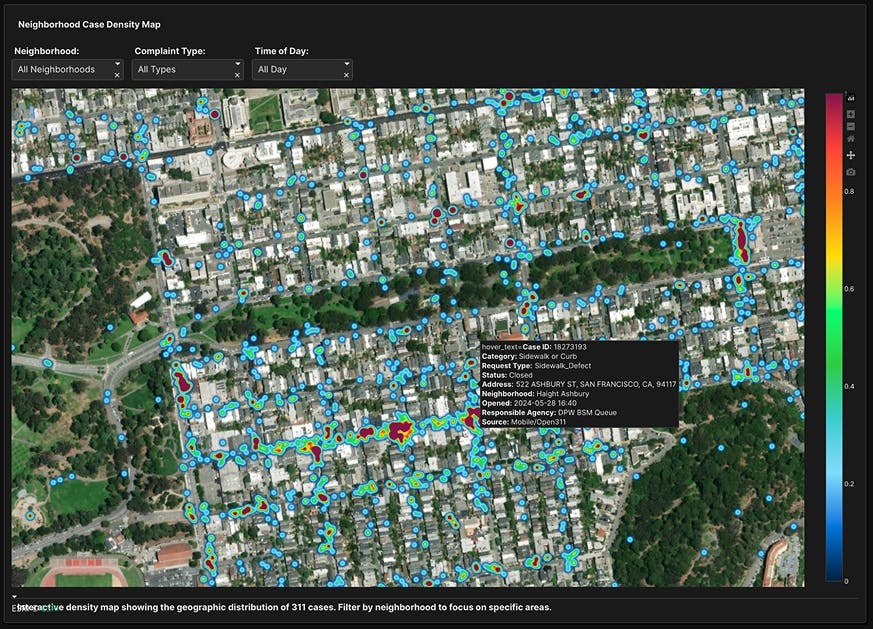
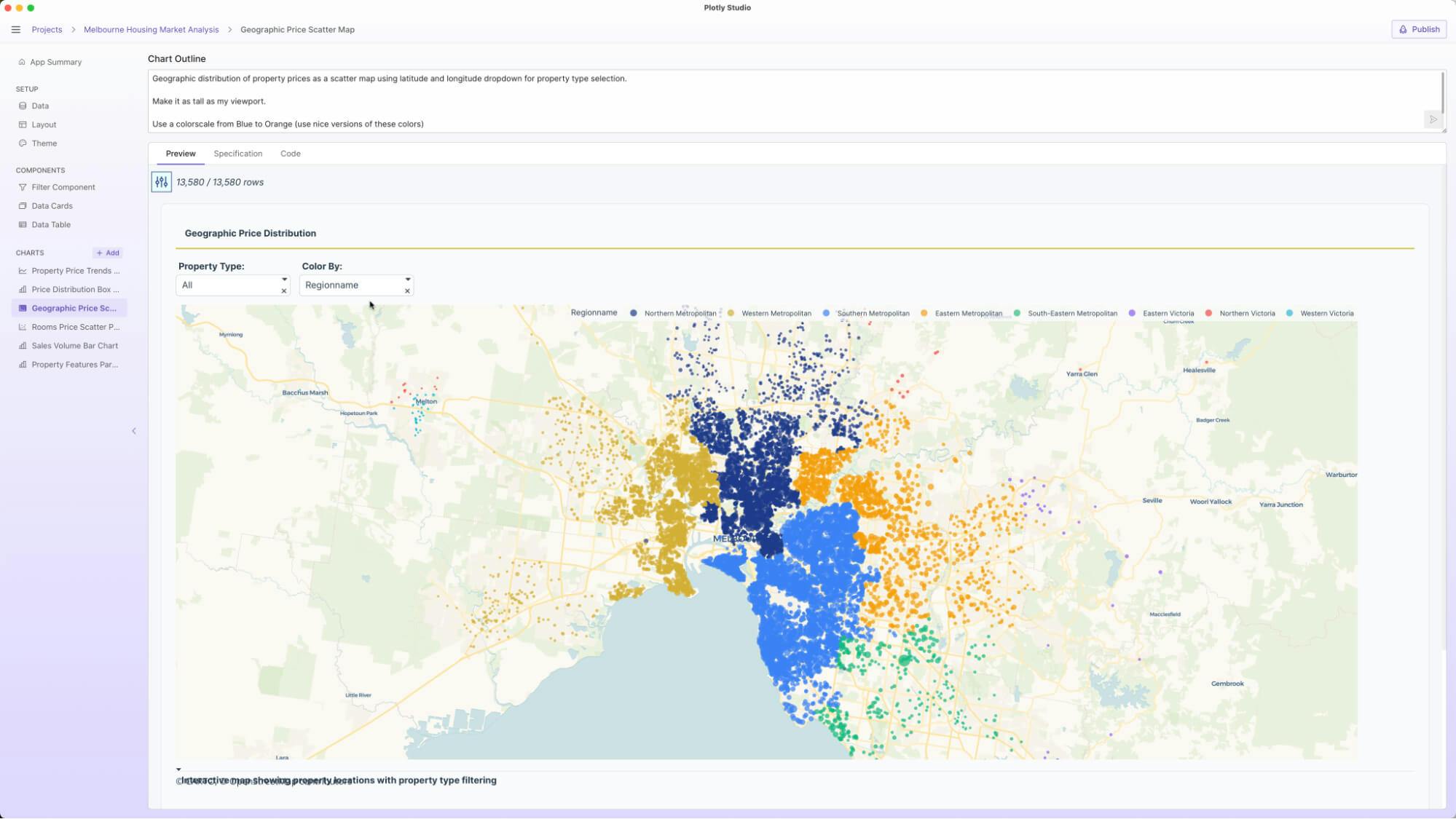
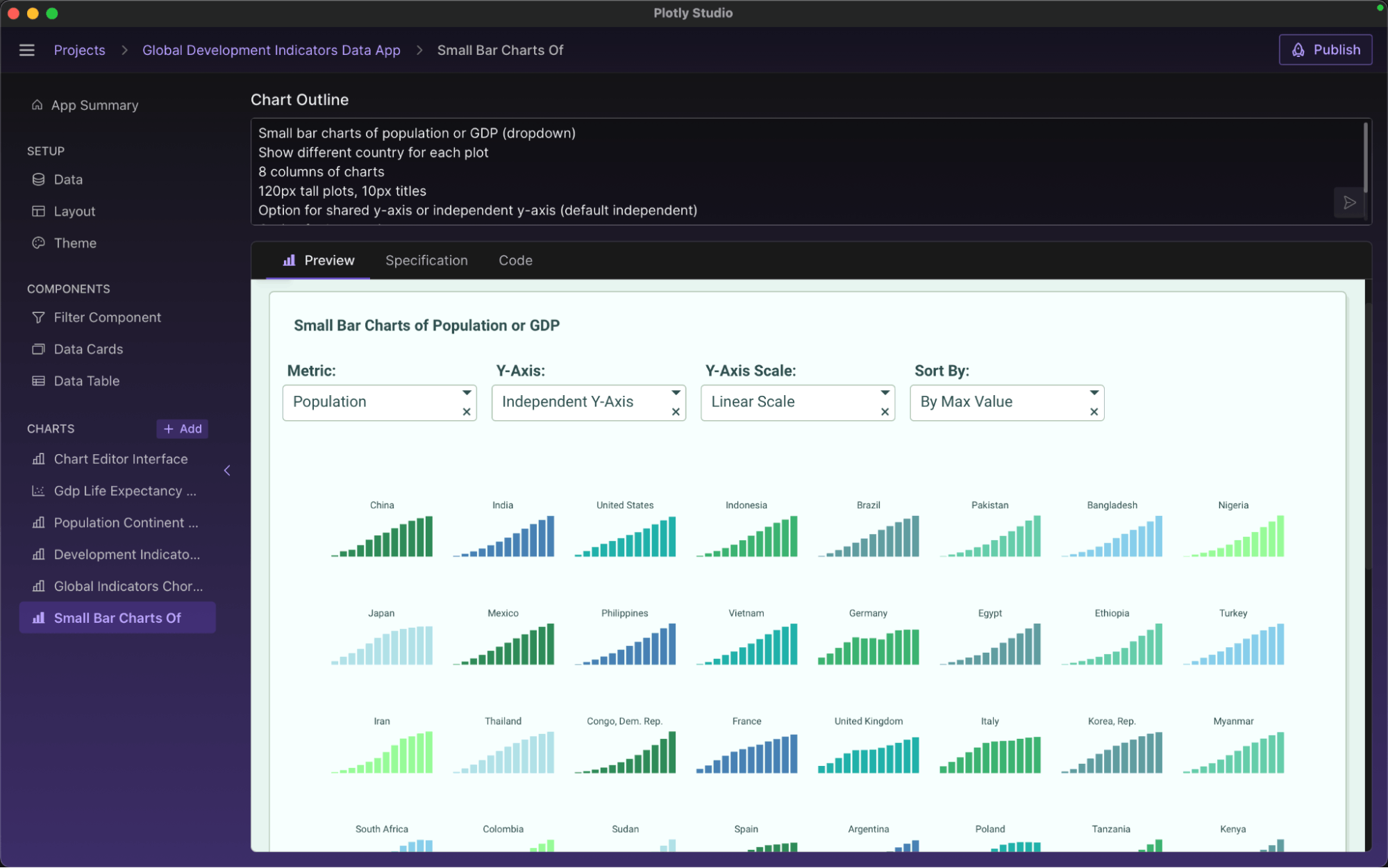
If you want to work faster without losing control, Studio is the better choice.
Sign up for early access and try it for free right now.